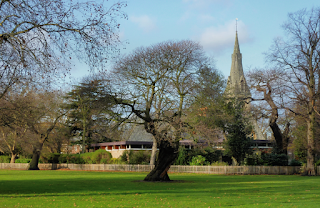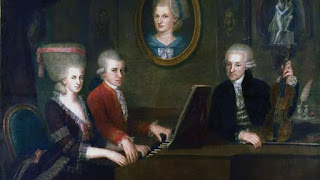In prehistoric times this was a coastal area and archaeological investigation has revealed evidence of Palaeolithic as well as (much later, obviously) Roman habitation. The name of Wanstead, which may have meant ‘white house’ or ‘house on the wen-shaped hill’ or ‘place where wagons are kept’, was first recorded in 824 and there was a woodland hamlet here by 1100.
Early settlement was confined to the vicinity of the manor house at what became Wanstead Park, with its nearby church of St Mary. Neighbouring farms progressively turned to market gardening as access to London improved. The village began to attract wealthy residents from the mid-18th century, considerably later than places such as Woodford. When the church was rebuilt in its present form in 1790 there were just 120 houses here, four-fifths of which were gentry-owned.
High-class suburban development began to the north around 1860, after the opening of a station at Snaresbrook. Visible in the photo above,* Christ Church was consecrated in 1861 and enlarged a few years later.
Diamond Jubilee fountain
Wanstead’s drinking fountain was built to celebrate Queen Victoria’s diamond jubilee and has been moved several times as the road has been widened.
More affordable estates were laid out in the south of the parish at Cann Hall and Aldersbrook around the turn of the century but in Wanstead itself builders continued to erect substantial houses until the outbreak of the First World War.
Smaller properties appeared after the war as developers sought to make the most of the few remaining plots.
The construction of the Eastern Avenue in the mid-1920s and the sale of Nightingale Farm in the late 1930s brought housing to the east and far north respectively.
After the Second World War and the opening of Wanstead station in 1947, construction was limited to the replacement of several hundred bomb-damaged houses, followed by later infilling and the construction of small blocks of flats in place of some of the largest old houses.
The High Street was redeveloped from the early 1970s, when many of its older buildings were demolished. Despite the plain appearance of the newer premises, the street retains a villagey air, aided by the presence of a large green on the west side.
The rerouting of the A12 to provide a better link to the M11 necessitated some demolition and tree-felling in the mid-1990s, in the face of active resistance by conservationists.
A ‘best London village’ award in 2002 reflected the wealth of green space on Wanstead’s doorstep, its well-preserved Victorian residences and – at the time – its value for money, although this has since become less evident. Most residents are white, middle-aged homeowners, but younger professionals have also been choosing to move here if they can afford it.
Wanstead’s residents have included the dramatist RB Sheridan, the politician George Canning and the poet Thomas Hood – who all lived at a variety of addresses in the London area – and William Penn, the founder of Pennsylvania.
Postal district: E11
Population: 11,543 (2011 census)
Station: Central line (zone 4)
Website: Parish of Wanstead: History
Further reading: Ian Dowling and Nick Harris, Wanstead and Woodford, Tempus, 1995
See also: Wanstead Flats
you still can't find work---OMG
You got a fast car We go cruising to entertain ourselves You still ain't got a job And I work in the market as a checkout girl I know things will get better You'll find work and I'll get promoted We'll move out of the shelter Buy a bigger house and live in the suburbs I remember we were driving driving in your car Speed so fast I felt like I was drunk City lights lay out before us And your arm felt nice wrapped round my shoulder And I had a feeling that I belonged And I had a feeling I could be someone, be someone, be someone You got a fast car I got a job that pays all our bills You stay out drinking late at the bar See more of your friends than you do of your kids I'd always hoped for better Thought maybe together you and me'd find it I got no plans I ain't going nowhere So take your fast car and keep on driving I remember when we were driving driving in your car Speed so fast I felt like I was drunk City lights lay out before us And your arm felt nice ...



Comments